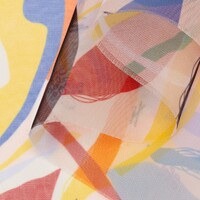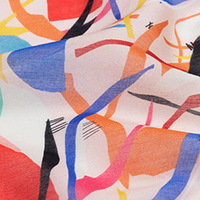Related:
Back to Site Stores ({{popupVm.storeTotalCount}})
Artists ({{popupVm.artistTotalCount}})
Printed voile fabric is great for crafting, home decos and interior designing, scarves, bridal wear, linin... Read More
Ships in 3 - 4 days
Delivery $15.50
Handmade
Voile is the same texture on both the front and back sides, which is a very fine textured mesh which feels like a very fine, delicate net. Extremely lightweight, it is incredibly airy, which lends itself to flags, blouses and dresses.
Browse our range of voile fabrics
Medium weight, stiff and non-stretch with a matte finish
100% polyester
Light weight, soft and non-stretch with a matte finish
100% polyester
70% cotton 30% silk lightweight woven voile. Print shows through 90% to reverse. Super bright colours & deep blacks using reactive ink chemistry. <b> Expect shrinkage of 1.25% weft, 3.75% warp.</b>
70% cotton 30% silk
Expected Shrinkage = Weft: 2% Warp: 1%
Care instructions
Wash at 30°c, low tumble dry heat, hang to dry, do not wring, low heat iron.




Voile is a sheer, lightweight fabric which is very fine. It can be made from a variety of different fibres, both natural or man made, which are high-twist and woven in plain weave. Voile, is french for veil, and this fabric gets that name as it was originally used as a veiling fabric. The yarns in voile material are known as "voile yarns" as they have been twisted together more than in normal yarns (but not quite as much as in crepe yarns) to create a rounded single yarn. Sometimes these are twisted together with another single yarn, in the same direction, to create a two-fold voile yarn. Due to it's soft sheer nature, voile is commonly used in bridal wear, but is also ideal for crafting, creating linings, scarves and clothing and dressmaking too, as well as home interior items.
You have different finishing options for your printed voile fabric. We can send it to you as it comes off the printer, with an undyed border around the edges, or we can cut your personalised design on the line, removing all of the white space. You may prefer to have one of our expert seamstresses hem your printed voile fabric. If so, then you can choose either black or white thread, and either an overlock or folded hem. If you choose to have your voile printing hemmed, please ensure to allow 6-8 mm on each side for fabrics up to 100 gsm, and 15-20 mm for other fabrics.
All your custom made printed fabric orders are printed digitally. We use different methods for this based on the type of textile that is being used. These methods include pigment printing, which prints onto a localised part of the fabric with coloured dyes, building up your personalised design. Another method we use is dye sublimation. This is a two step process in which we first print your design onto a transfer paper, and that is then bonded using heat to the fabric itself. Both of these methods create a long-lasting, full colour print.
We print at 200dpi, which is a good combination of quality and file weight. Ideally, your image should be scaled to 100% at 200dpi; this means that no resizing of your file occurs, preventing any interpolation. Our design interface will have a quality marker next to the design that you have uploaded, this will change colour using a traffic light system and display a message. The message will let you know if the resolution is too low or if you have a good quality image.
When you upload your design our system will automatically scale it to fit your chosen fabric dimensions. In the ‘Product Options’ tab, the displayed dimensions under ‘Print Size’ will show the dimensions of the piece of fabric that you are ordering. For image/design dimensions you need to see the ‘Images & Text Tools’ tab. You can see and edit the dimensions of the image under the quality information next to the thumbnail.
We advise providing images in the RGB colour space. Specifically using the sRGB image profile, to achieve best colour results. What does this mean? In your editing software choose RGB as the working space, and assign the image profile as sRGB (full name sRGB IEC61966-2.1)
For most of our fabrics, there is no limit on the length of the fabric that you can order. We have a preview design window set up to 10m max to visualise the print, but that's not a print limit. If you'd like to order more, increase the quantity (x2 for 20m or x4 for 40m for example) and then you can order as much as you'd like, with a built-in automatic volume discount too. The maximum print width of each fabric can be found on the individual fabric pages or in our design interface.
Yes, that might help you! Always incorporate any extra space or boarders into your purchased fabric size. We trim squarely around fabric samples and fabric prints, leaving approximately 5mm white space. Cutting neatly on the line has an additional fee.
Crocking, which is fading along the creases, often after washing or heavy use, occurs when you digitally print on natural fabrics - more so when dark or dense colours are used. It can be minimised by using a cool hand wash instead of machine washing as the tumbling of the machine is the main cause of this. To avoid entirely, we would advise using a poly fabric.
Our organic fabrics do not have any coatings that the non-organic fabrics have. This means the ink absorbs into the fibres, reducing the colour strength slightly (by approx. -40%). For super strong colours we recommend a non-organic natural fabric.
Unfortunately not; we like to test meticulously so that we know what gets best results on our fabrics, and our facilities cater perfectly to them. We do however print sublimation paper to order, and if you have access to a heat press you can press your own fabrics easily.
For multi-coloured or very detailed files we recommend using a tiff format, but they must be flattened. For simple colours and low detail files, a jpeg is fine.
Just like many fabric printing processes, there is the potential for shrinkage. Depending on the fabric, please expect and allow between 2-8% shrinkage which you need to plan for in your dimensions. This percentage can vary from print run to print run and between fabrics, so we would advise ordering a little more material than you require for your project.
We do not offer to print on both sides of the fabric. A lot of our fabrics are semi-transparent or have some show through and this wouldn't work with double-sided printing. This is not a service that we offer on any of our fabrics.
At the moment no, our labels are all printed on the same satin fabric. We may introduce more in the future, but for now, this is the best choice. The labels are all cut the same way. You can order the fabric of your choice and make the labels yourself, but we do not cut different fabric into label format.
With environmental consciousness in mind, our fabrics are all printed using completely water-based inks. This means no chemicals or solvents are used. Our heat fixing procedure fixes the colours and prints, avoiding the downsides of steaming, such as excess or contaminated water returning into the waste system. We have one facility in London where we conduct all the printing, production and fulfilment. Rather than roll the fabrics, or send them in a tube, we fold them before they are sent out to you. This saves over 150 tubes a week, as well as a lot of space on the delivery van. (For delicate fabrics we ensure to package appropriately).
We work at improving our colour profiles all the time. Though rare it may happen that from one print run to another, and there could be slight colour differences, this is normal and part of the process when we are constantly improving. It is extremely unlikely that there will be a huge difference (like orange instead of red for example). Please bear in mind such colour variations can be intensified from fabric to fabric due to the varying grains and textures of the fabric; natural fabrics tend to have more muted colours than their poly alternatives. This is due to the construction of the materials as well as the print methods that have to be altered slightly for more delicate, natural textiles.
We have a full Cut & Sew service here at Bags of Love, and are able to hem your fabric prints for a small additional charge. We create a small one- or two-fold hem that typically uses 5 to 20mm of material, depending on the thickness of the fabric. So, for example, if you want a finished piece of fabric that measures 100 x 100cm, you will need to order a size of 101.5cm x 101.5cm to allow for the hem (on top of that please also allow for shrinkage of min 2%). The thicker the fabric, the bigger the hem will be. You can choose to have your prints hemmed with either Black or White thread. On our silk and other light woven fabrics, one hemmed edge will be straight (vertically down the roll) and the other will be slightly rippled. The hemming material allowances are as follows and you need to make your print bigger to accommodate the hem:
For further information about our fabrics see our FAQs.
Please note: As everything we provide is handmade to order, you may find a slight variance in the sizes.







